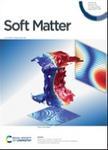版权所有:内蒙古大学图书馆 技术提供:维普资讯• 智图
内蒙古自治区呼和浩特市赛罕区大学西街235号 邮编: 010021

作者机构:Shenzhen Univ Inst Adv Study Guangzhou 518060 Guangdong Peoples R China Univ Oxford Dept Chem Phys & Theoret Chem Lab South Parks Rd Oxford OX1 3QZ England
出 版 物:《SOFT MATTER》 (软物质)
年 卷 期:2017年第13卷第46期
页 面:8678-8683页
核心收录:
学科分类:081704[工学-应用化学] 07[理学] 070304[理学-物理化学(含∶化学物理)] 08[工学] 0817[工学-化学工程与技术] 0805[工学-材料科学与工程(可授工学、理学学位)] 0703[理学-化学] 0702[理学-物理学]
基 金:Marie Curie actions Shenzhen University
主 题:Frustration Material properties wall image analysis algorithm Particle shape structural disorder Surjective Cytoskeletal Filaments High density confocal microscopy
摘 要:Confocal microscopy was used to directly observe the structural coarsening of the first layer of short colloidal rods sedimented onto a flat wall. Based on an image analysis algorithm we devised, quantitative information on the location, orientation and length of each particle can be extracted with high precision. At high density the system undergoes structural arrest, and becomes trapped in a disordered state of randomly arranged filaments that are composed of side-by-side aligned rods. The frustration of structural order is signalled by a new peak that emerges in the radial distribution function. Configuration analysis shows that the peak is primarily due to pairs of particles that are arranged in a T shape, a configuration that is compatible with neither crystallization nor filament growth. Our results point to a self-poisoning mechanism for the frustration of structural order, and highlight the importance of particle shape in controlling colloidal assembly thus materials properties.